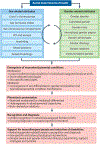Sex and gender in neurodevelopmental conditions
- PMID: 36747038
- PMCID: PMC10154737
- DOI: 10.1038/s41582-023-00774-6
Sex and gender in neurodevelopmental conditions
Abstract
Health-related conditions often differ qualitatively or quantitatively between individuals of different birth-assigned sexes and gender identities, and/or with different gendered experiences, requiring tailored care. Studying the moderating and mediating effects of sex-related and gender-related factors on impairment, disability, wellbeing and health is of paramount importance especially for neurodivergent individuals, who are diagnosed with neurodevelopmental conditions with uneven sex/gender distributions. Researchers have become aware of the myriad influences that sex-related and gender-related variables have on the manifestations of neurodevelopmental conditions, and contemporary work has begun to investigate the mechanisms through which these effects are mediated. Here we describe topical concepts of sex and gender science, summarize current knowledge, and discuss research and clinical challenges related to autism, attention-deficit/hyperactivity disorder and other neurodevelopmental conditions. We consider sex and gender in the context of epidemiology, behavioural phenotypes, neurobiology, genetics, endocrinology and neighbouring disciplines. The available evidence supports the view that sex and gender are important contributors to the biological and behavioural variability in neurodevelopmental conditions. Methodological caveats such as frequent conflation of sex and gender constructs, inappropriate measurement of these constructs and under-representation of specific demographic groups (for example, female and gender minority individuals and people with intellectual disabilities) limit the translational potential of research so far. Future research and clinical implementation should integrate sex and gender into next-generation diagnostics, mechanistic investigations and support practices.
© 2023. Springer Nature Limited.
Conflict of interest statement
Competing interests
The authors declare no direct conflict of interest related to this article. S.B. discloses that he has in the last 3 years acted as an author, consultant or lecturer for Medice and Roche. He receives royalties for textbooks and diagnostic tools from Hogrefe, Kohlhammer and UTB, and editorial honorarium from SAGE Publications. S.B. is a shareholder in NeuroSupportSolutions International and SB Education/Psychological Consulting. P.B.M. has received royalties for textbooks from Springer and Urban & Fischer and editorial honorarium from Elsevier. Z.J.W. has received consulting fees from Autism Speaks, the May Institute, and Roche; he also serves on the Autistic Researchers Review Board of the Autism Intervention Research Network for Physical Health (AIR-P). L.G. has acted as a consultant to Kingdom Therapeutics. M.-C.L. has received editorial honorarium from SAGE Publications.
Figures


References
-
- Poeschl G A hundred years of debates on sex differences: developing research for social change. J. Soc. Polit. Psychol 9, 221–235 (2021).
-
- Joel D Beyond the binary: rethinking sex and the brain. Neurosci. Biobehav. Rev 122, 165–175 (2021). - PubMed
Publication types
MeSH terms
Grants and funding
LinkOut - more resources
Full Text Sources
Medical

